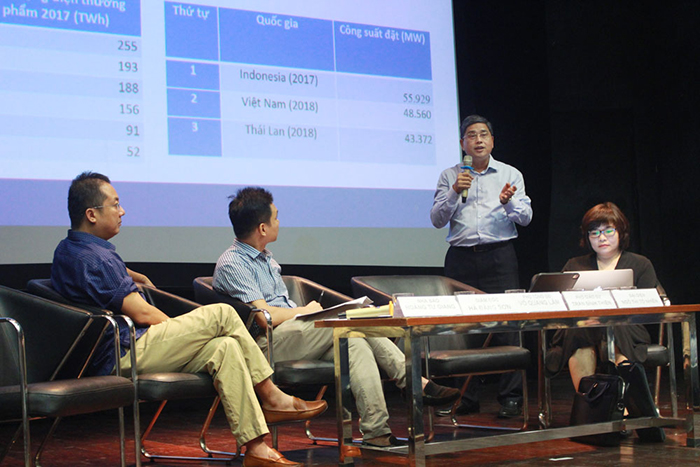The event was organized by Live and Learn for Environment and Community Center (Live & Learn) in collaboration with Vietnam Initiatives for Shifting Energy (VIET SE). Mr. Vo Quang Lam - Deputy General Director of Vietnam Electricity attended the talkshow and presented the overview of Vietnam's Power sector and the situation of power source development under the Adjusted Power Planning VII.
Solar power cannot replace traditional ones
Under the Adjusted Power Planning VII, by 2020, the total capacity of solar power is estimated at 850MW. However, as of June 2019, the total capacity of solar power has reached 4,500MW. By 2020, this figure is expected to reach 7,700MW, much higher than the planned target.
Many people think that strongly developing solar power is the "solution" to relieve the concern over the power shortage in the coming time. In fact, according to experts, solar power just meets a very small part in the total power demand of the whole nation.
Mr. Vo Quang Lam – EVN’s Deputy General Director said that the total commercial power output of 2019 is expected at 212 billion kWh. Thus, on average, the whole country needs about 750 million kWh per day. Meanwhile, on the most recent peak (August 21st), solar power output was only 27 million kWh, the remaining output was generated by traditional power sources such as coal power, gas power, hydropower, etc.
In general, renewable energy sources play an important role in ensuring power supply, but the development of traditional power sources in Vietnam still needs to be thoroughly considered. Solar power sources just generate capacity in about 6 hours during the daytime; For the remaining 18 hours, the power system still needs to mobilize traditional energy sources.
Besides, solar power projects developing in excess of the planning will pose big obstacles to their release of capacity. Building a solar power plant only takes 6-10 months, but a 500kV transmission line takes 3-5 years for completion, and a 10kV line takes about 1 year.
Mr. Ha Dang Son - Director of the Center for Energy and Green Growth Research affirmed that the problem of power source structuring cannot be solved in a "random manner", the model of a country cannot be applied to another. For example, renewable energy in Germany develops very dramatically, but if this country were not connected its power grid to that of other European nations, it would face many difficulties in ensuring power supply.
Currently in Vietnam, full potential of hydropower has been exploited; The development of wind and solar power is highly positive, but the prices are high and just useful in some certain times of the day. Therefore, Vietnam still needs to develop coal and gas power.

EVN’s Deputy General Director Vo Quang Lam (second from the right) presenting at the talk show - Photo: Truong Hung
Responsibility of power users needs to be considered
According to Associate Prof. and Dr. Nguyen Hong Thuc - Institute for Resettlement and Energy Research, ensuring energy security is not the concern of Industry and Trade Ministry or EVN only, power users need to undertake this obligation.
EVN is being "alone", struggling to meet the power demand growth of 10% per year, meanwhile, the integration of energy efficiency has not been paid much attention to by investors. In fact, currently, many high-rise buildings are wasting 20-40% of energy, said Associate Prof. and Dr. Nguyen Hong Thuc.
Assoc., Prof. and Dr. Nguyen Hong Thuc took an example that in UK, since 2016, high-rise buildings have been provided with a specific energy amount only, and shall perform solutions to produce power and water consumption for themselves. Her opinion was: "Vietnam needs to work out comprehensive solutions for economical and efficient use of power, reducing the current power growth of 10%".
Mrs. Ngo To Nhien – member of Vietnam Initiatives for Shifting Energy shared that recently, the Vietnamese Government has focused on energy saving and developed a comprehensive system of legal documents and regulations, but the implementation has not been much noticed.
Inefficient mechanism of sanction/reward to encourage or deterrent as well as low power prices are the main reasons that make power users not determined to save energy.
For more information on this issue, Mr. Vo Quang Lam said that Vietnam’s elasticity coefficient of power/GDP is still high (1.5). Recently, EVN has been implementing many power saving programs and further promoting solutions for managing power users such as: Program of power demand management; power load adjustment; rooftop solar power development, etc.
In the power use structure of Vietnam, the industrial sector accounts for 55%, the domestic activities accounts for 32%. It is assumed that the national commercial power output is 100 billion kWh, if each sector saves 1% of their power use, the efficiency will be great, equivalent to a 1,000MW power plant.